 Fisheries production went down by 4.06 percent
Fisheries production went down by 4.06 percent
Overall, the total volume of fisheries production in Davao Region was recorded at 15,412.74 metric tons during the first quarter of 2019. It was lower by 4.06 percent compared from 16,064.57 metric tons of production in the same quarter of last year.
Of the total fisheries output, about 51.6 percent of the regional production was attributed in the aquaculture subsector. Municipal fisheries contributed 43.88 percent, composed of marine and inland fisheries at 43.50 percent and 0.30 percent, respectively. Meanwhile, production from commercial fisheries showed the least contribution at 4.50 percent during the first quarter of 2019.
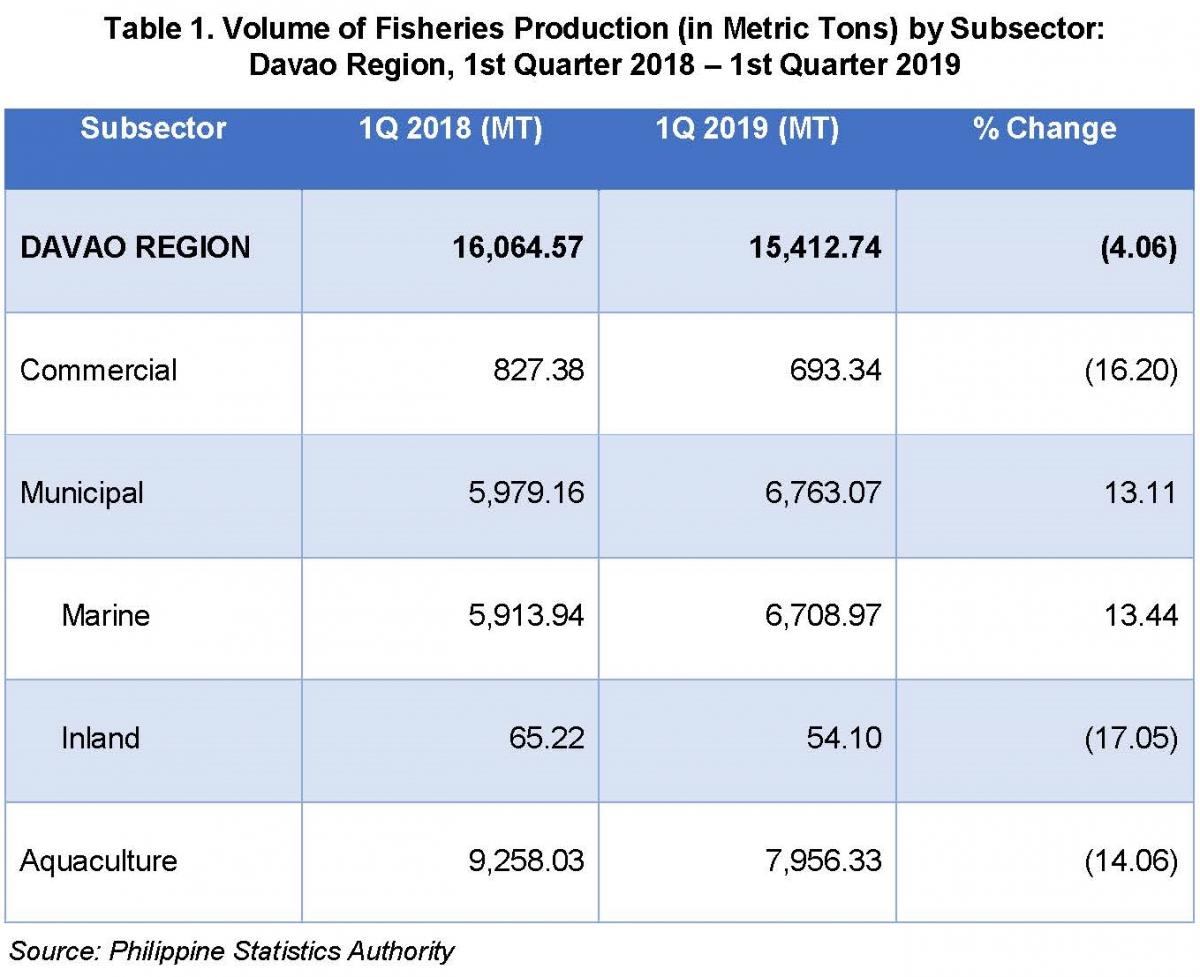
Commercial Fisheries Production
Commercial fishing in Davao Region registered a 16.20 percent decreased in its production from 827.38 metric tons in the first quarter of 2018 to 693.34 metric tons in first quarter of 2019.
By province, about 40.8 percent of the commercial output were posted in Davao Oriental. Davao City’s production contributed about 39.0 percent, while 16.7 percent was accounted in Davao Occidental. There were 3.5 percent of commercial outputs that were unloaded in Davao del Sur. On the other hand, the provinces of Davao del Norte and Compostela Valley are not part of the Commercial Fisheries Survey since there are no commercial fishing operations administered in both provinces.
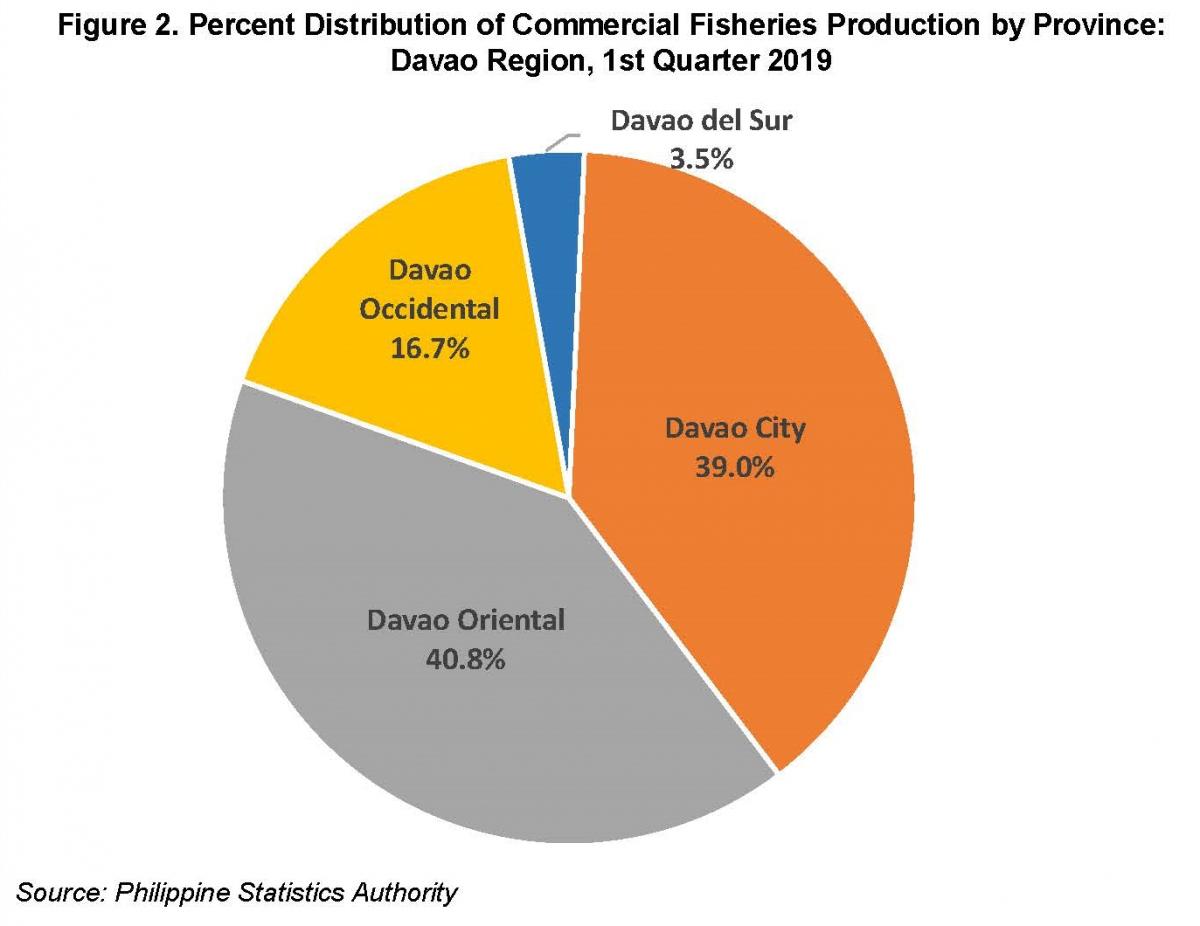
Davao Region’s commercial species with most volume of production during the first quarter of 2019 were the following: Yellowfin tuna, Roundscad and Frigate tuna.
- The volume of unloading of Yellowfin tuna was estimated at 176.37 metric tons, higher by 74. 94 percent compared to the output of the same period in the previous year.
- Roundscad production posted about 144.66 metric tons, a 7.72 percent dropped in its production.
- About 69.62 metric tons of Frigate tuna was produced in the region. This figure climbed by 25.87 percent from the same quarter of previous year’s level.
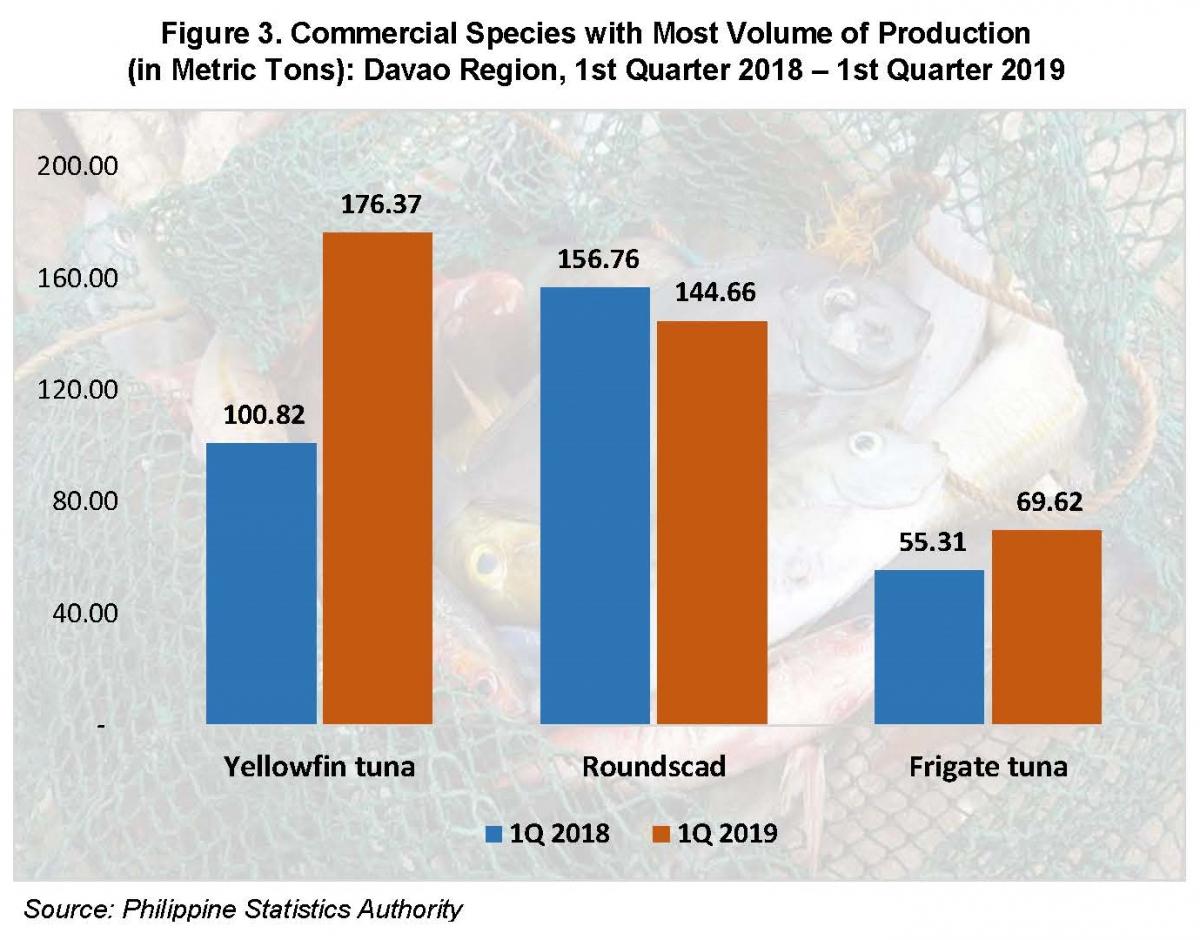
Municipal Fisheries Production
Municipal fisheries in Davao Region has a total production of 6,763.07 metric tons. This figure grew by 13.11 percent from 5,979.16 metric tons output level in the first quarter of 2018. The volume of municipal production was comprised of 99.20 percent marine fisheries, while the remaining was contributed by inland fisheries.
About 47.10 percent of the municipal production in Davao Region were caught in the province of Davao Oriental. In Davao Occidental, it revealed that its contribution in the outputs was approximately 40.7 percent. The municipal fisheries produced in the provinces of Davao del Sur, Davao del Norte and Compostela Valley accounted to 5.3 percent, 3.0 percent and 2.8 percent, respectively. Meanwhile, minimal production were recorded in Davao City at 1.2 percent.
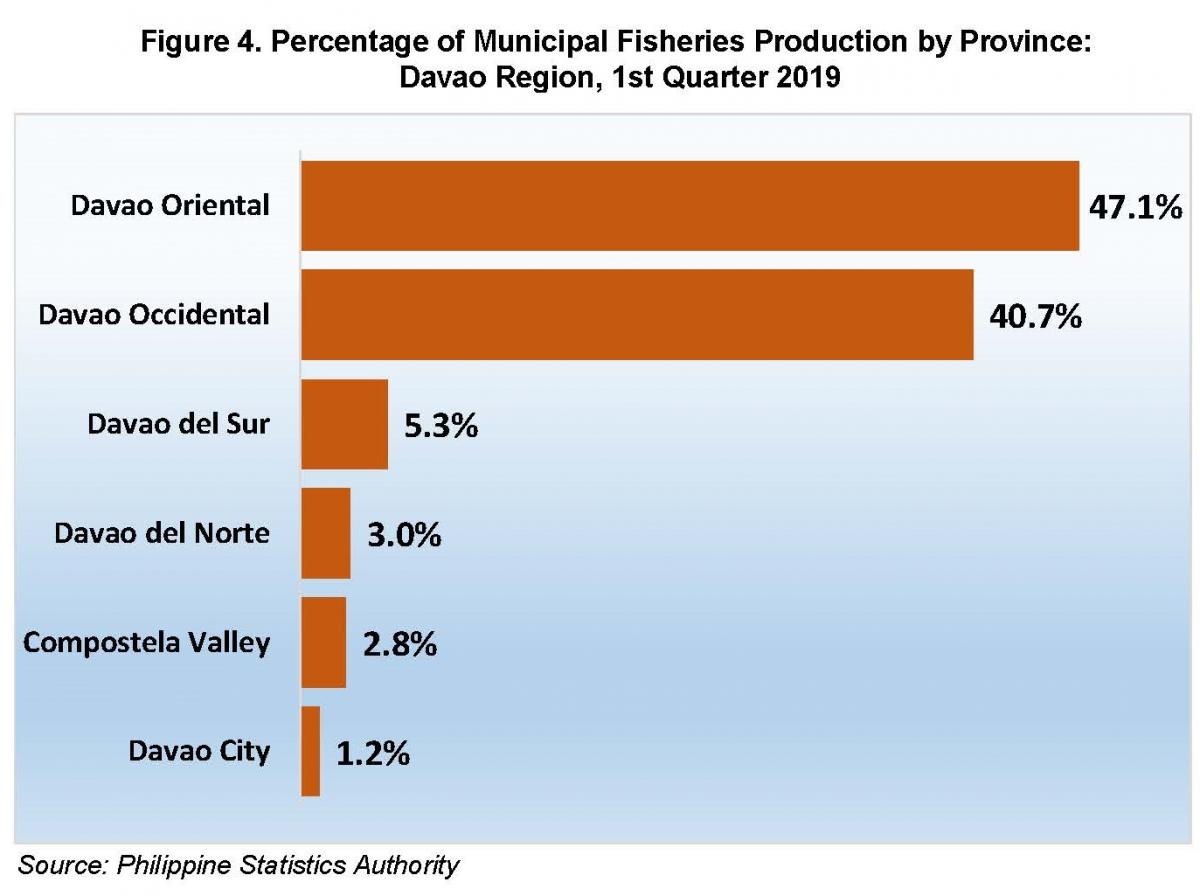
Marine Municipal Fisheries
During the first quarter, marine municipal production of Davao Region revealed a positive growth of 13.11 percent from 5,913.94 metric tons in the same period of 2018 to 6,708.97 metric tons.
Marine species with the highest catch during the first quarter of 2019 were as follows: Skipjack, Yellow fin tuna and Frigate tuna.
- A dominant production of Skipjack was revealed, with an estimated volume at 858.95 metric tons. It exhibited an increment of 13.89 percent from the level of output in same quarter of the previous year.
- Yellowfin tuna production in the municipal fisheries at 645.30 metric tons went down slightly by 6.82 percent from the 2018 first period output at 692.56 metric tons.
- Increased production of Frigate tuna was noted during the first quarter at 41.11 percent. Davao Region’s output reached to 612.60 metric tons from 434.13 metric tons in the last year.
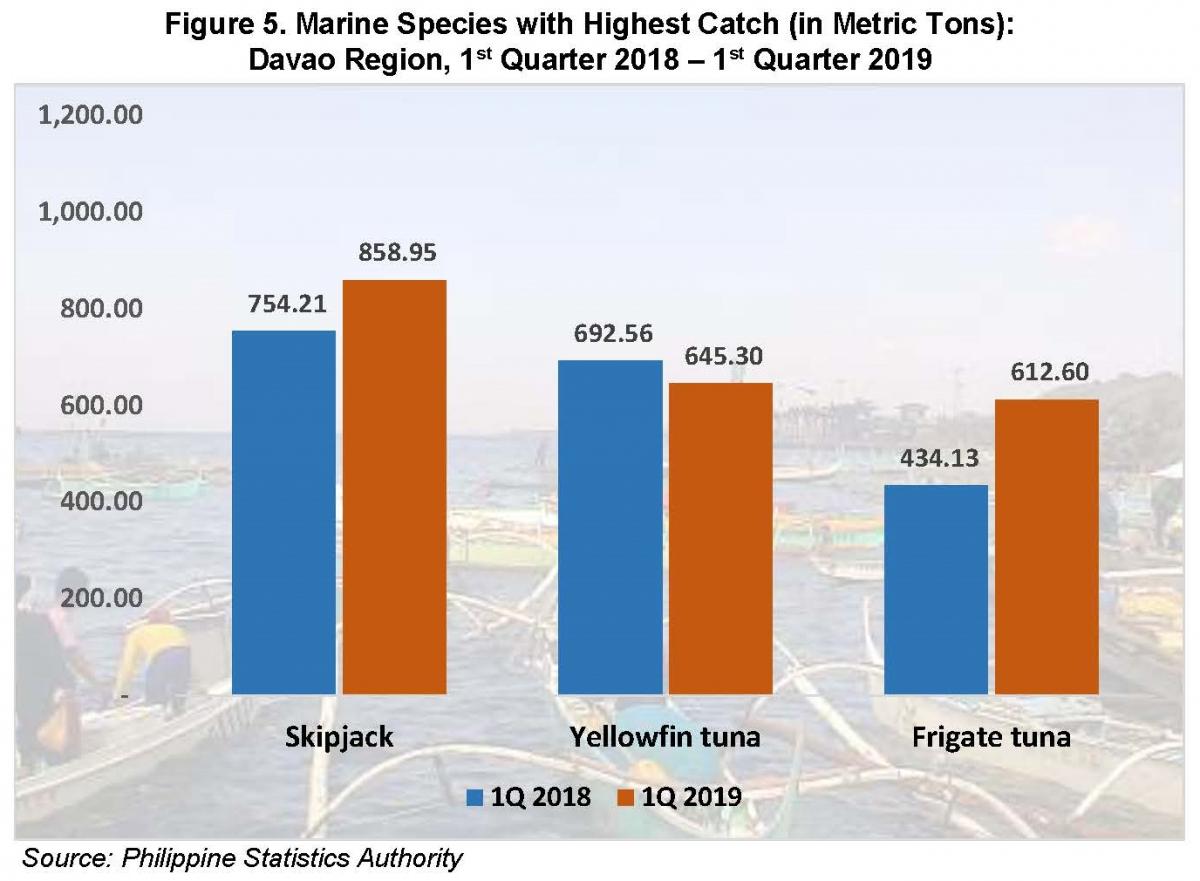
Inland Municipal Fisheries
Inland fisheries production in Davao Region posted a 17.05 percent decline from first quarter of last year’s production at 65.22 metric tons compared to this year’s production level in the same quarter at 54.10 metric tons.
Out of the inland fisheries production in Davao Region, about 75.66 percent of the species caught in the inland waters were fishes. Meanwhile, there were 20.74 percent of the production were Molluscs and the remaining percentage were Crustaceans.

Aquaculture Production
Aquaculture production in Davao Region during the first quarter recorded a total of 7,956.33 metric tons. It fell short by 14.06 percent from the previous year’s mark at 9,258.03 metric tons.
The province of Davao del Sur showed substantial contribution in the production of aquaculture at 68.51 percent. The province of Davao Occidental came next with 17.00 percent of the outputs. Meanwhile, single-digit percentage of production were recorded in the following: Davao City (7.31 percent), Davao del Norte (4.77 percent) and Davao Oriental (1.53 percent). On the other hand, least percentage of aquaculture fisheries were harvested during the first quarter in Compostela Valley at 0.89 percent.

During the first quarter of 2019, the aquaculture species with major harvests were as follows: Seaweeds, Milkfish and Catfish.
- Production of Seaweeds was estimated at 4,476.84 metric tons, which declined by 21.13 percent from the same quarter level of the previous year.
- Milkfish production was estimated at 2,599.86 metric tons and exhibited a 12.05 percent reduction from the previous year’s level.
- Volume of harvests for Catfish reached to 223.29 metric tons. It surpassed its 2018 same quarter output by 32.97 percent.

TECHNICAL NOTES
This Special Release presents the data on volume of production of fisheries for the first quarter of year 2018 in Davao Region. It contains information on the current situation by major species of the three (3) fisheries subsector, namely: commercial and municipal fisheries, and aquaculture. It serves as output of the four (4) fisheries surveys regularly conducted by the Philippine Statistics Authority (PSA). The surveys are: Quarterly Commercial Fisheries Survey (QCFS), Quarterly Municipal Fisheries Survey (QMFS), Quarterly Inland Fisheries Survey (QIFS) and Quarterly Aquaculture Survey (QAqS).
Fisheries - all activities relating to the act or business of fishing, culturing, preserving, processing, marketing, developing, conserving and managing aquatic resources and the fishery areas including the privilege to fish or take aquatic resources thereof (RA 8550).
Fisheries Sector - the sector engaged in the production, growing, harvesting, processing, marketing, developing, conserving and managing of aquatic resources and fishery areas.
Commercial fishing – is the catching of fish with the use of fishing boats with a capacity of more than three gross tons for trade, business or profit beyond subsistence or sports fishing.
Marine Municipal Fishing - covers fishing operation carried out with or without the use of a boat weighing three gross tons or less.
Inland Municipal Fishing - the catching of fish, crustaceans, mollusks and all other aquatic animals and plants in inland water like lakes, rivers, dams, marshes, etc. using simple gears and fishing boats some of which are non-motorized with a capacity of three gross tons or less; or fishing not requiring the use of fishing boats.
Aquaculture - fishery operation involving all forms of raising and culturing of fish and other fishery species in marine, in fresh, brackish and marine water areas. The operation is comprised of activities from stocking to harvesting of species under controlled conditions in farming facility called aquafarm.
Landing Center - place where the fish catch and other aquatic products are unloaded and traded.
Traditional Landing Center - usually with no structures and no payment are collected for unloading of catch by boats.
Non-Traditional Landing Center - are those managed by the Philippine Fisheries Development Authority (PFDA), Local Government Units (LGUs) and private individuals, corporations, etc. and usually with structures and imposes fee for the maintenance of such.
Fishing Boat - is a type of watercraft, such as motorized/non-motorized banca, sailboat, motorboat, etc., either licensed or not, used for fishing purposes.
Fishing Grounds - are areas in any body of water where fish and other aquatic resources congregate and become target of capture.
Fishing Gear - any instrument or device and its accessories utilized in taking fish and other fishery species.
Aquafarm - the farming facilities used in the culture or propagation of aquatic species including fish, mollusk, crustaceans and aquatic plants for purposes of rearing to enhance production.
Brackish water – is a mixture of seawater and freshwater with salinity that varies with the tide. Examples are estuaries, mangroves and mouths of rivers where seawater enters during high tide.
Freshwater – is water without salt or marine origin, such as generally found in lakes, rivers, canals, dams, reservoirs, paddy fields and swamps.
Marine Water - refers to inshore, open waters and inland seas in which the salinity generally exceeds 20 ppt. (parts per thousand).
APPROVED FOR RELEASE:
RUBEN D. ABARO JR.
OIC-Regional Director
